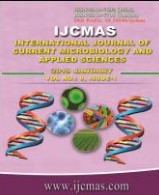


 National Academy of Agricultural Sciences (NAAS)
National Academy of Agricultural Sciences (NAAS)

|
PRINT ISSN : 2319-7692
Online ISSN : 2319-7706 Issues : 12 per year Publisher : Excellent Publishers Email : editorijcmas@gmail.com / submit@ijcmas.com Editor-in-chief: Dr.M.Prakash Index Copernicus ICV 2018: 95.39 NAAS RATING 2020: 5.38 |
Candida species are a common cause of neonatal nosocomial bloodstream infections in infants and are a leading cause of infectious-related mortality in the neonatal intensive care unit (NICU). The objective of this study was to determine the predominant organisms, antifungal sensitivity patterns and clinical risk factors in neonatal fungal blood stream infection cases (BSI) admitted to our hospital. This is a retrospective study of all neonatal fungal BSI cases between May 2018 and October 2018. Fungal sepsis was found in 25/210 (11.9%) of cases. Non Albicans candida (NAC) species were responsible for 85% of cases with Candida glabrata 11 (44%) as the most predominant species. Other species isolated were C. tropicalis 5 (20%), C. albicans 4 (16%), C. paraspinolosis 3 (12%), C. krusei 1 (4%) and C. Kodo 1 (4%). Antifungal sensitivity results showed that most of the NAC isolates especially Candida glabrata, Candida paraspinolosis were resistant to flucanazole, than Candida albicans. Amphotericin B showed more sensitivity than FLK over NAC species. The increase in neonatal fungal BSI and resistant organisms highlights the need to reanalyze use of strict infection control strategies, appropriate preventive and therapeutic measures such as prophylactic antifungal use and a restrictive policy of antibiotic use.
 |
 |
 |
 |
 |